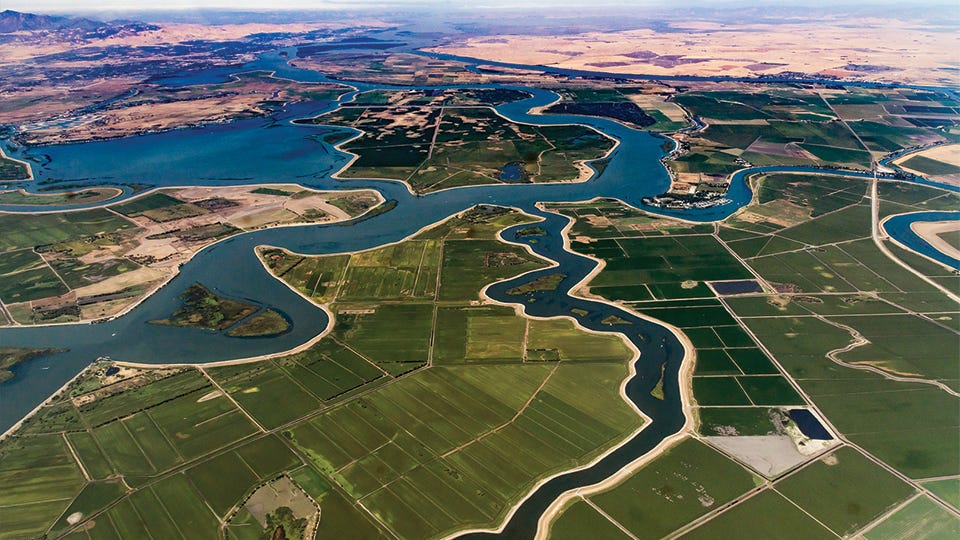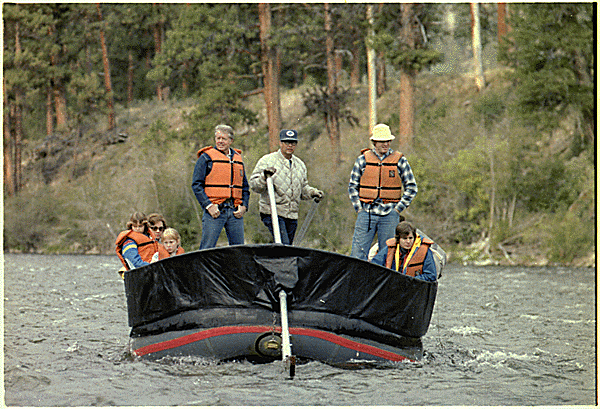Welcome to the last Western Water Notes of 2024.
I’m sorry for my slowness in writing. Between the holidays, and getting the December ick that’s going around, suddenly it’s the 30th, and the new year is arriving much faster than I imagined.
First, a note of gratitude. I launched this newsletter in 2023, but I did not start writing on here in earnest until this year. It’s been an experiment for me, and I’m learning as I go. I’m grateful to everyone who has signed up, stuck with it this first year, and supported my work. Thank you.
For me, 2024 was a year of personal and professional change. I’m looking forward to starting the new year on more stable ground and sharing writing that highlights a range of voices and ideas from different disciplines. My goal remains the same: To share stories and knowledge about our relationship to water in the West and to make the invisible a little more visible.
If you have ideas for posts, get in touch…
Onto the usual housekeeping: To get all my posts in your inbox, you can subscribe below. This newsletter is free, but if you find my work valuable and want to support it, please consider the monthly or yearly subscription plans. You can also support my writing by sharing these posts with friends or on social media. As always, drop me a line with feedback or suggestions.
Starting with a postscript to my last newsletter about the public rift among Colorado River negotiators over how to share an over-allocated river in a time of less water.
The Colorado River is managed, regulated, and plumbed through a century’s worth of compacts, contracts, case law, and treaties so voluminous that, taken together, these documents are known as the Law of the River. The Law is so complex and technical that sometimes it is all too easy to get lost in the weeds (where I too often reside).
The weeds are important, and context matters. But details often obscure the reality that, at the end of the day, it all comes back to water, and who has a priority to use it in a future present where there is less to go around. And the mega-drought has been a wake-up call. Water users have gone from dancing around climate change to talking directly about what cuts look like when there is far less water than once planned for.
To recap: The states upstream on the Colorado River — Colorado, New Mexico, Utah and Wyoming — have never used their full allotment from the 1922 Compact, which assumed a much larger river than the 20th Century average and a much, much larger river than the 21st Century average. The states downstream in the Lower Basin grew beyond their apportionment, and have spent more than a decade cutting use, a painful and costly process. Everyone today recognizes a need to cut back to bring demand in line with a supply that is shrinking as the climate changes. The only question is how.
The Lower Basin states of Arizona, California and Nevada says everyone needs to cut when there are acute shortages. But the Upper Basin states do not want to give up any water. They argue that when it’s a dry year, they are first to feel impacts and bear the full force of climate change. After all, these states have never used their full allotment.
And they want to one day use more water.
There are plans to build:
At the conference I wrote about in my last post, negotiators for the two basins stuck to their talking points, albeit with more pointed language than usual. But what is not discussed usually tends to be much more interesting: And a week after the gathering, Aspen Journalism’s Heather Sackett dropped a very insightful story about conditional water rights that lie in wait for Colorado to one day store more water from the river.
The water rights could be used to fill reservoirs that have not yet been built, and the story captures some of the underlying tensions in negotiations over the river’s future:
An analysis by Aspen Journalism found that across Colorado’s Western Slope, cities, conservancy districts, fossil fuel companies and private entities hold conditional water rights that would store about 2.6 million additional acre-feet from the Colorado River and its tributaries in not-yet-built reservoirs each bigger than 5,000 acre-feet. This is a staggering amount of water storage and more than the entire state of Colorado currently uses from the Colorado River basin, which is about 2.1 million acre-feet a year. [emphasis added]
…
The Upper Basin’s dreams of water development also highlight a central tension at the heart of the current disagreement between the Upper Basin and the Lower Basin states of California, Arizona and Nevada. The two sides have not been able to reach an agreement about how the river’s two largest storage buckets, Lake Powell and Lake Mead, should be operated in the future and how cuts should be shared in drought years. Negotiations are currently at an impasse.
…
“It’s especially a problem when we’re trying to find more water to reduce the amount of depletion on the Colorado River,” said Mark Squillace, a natural resources law professor at the University of Colorado Boulder. “If all these water rights were developed, it would be a disaster. I think everybody understands that.”
Pipe dreams? Perhaps.
Or from the point of view of California’s negotiator, “that’s crazy,” as he said to Aspen Journalism. But it’s something to watch. And the story joins other recent mapping that has attempted to outline the full scope of proposed dam and diversion projects across the Upper Colorado River Basin. Earlier this year, Great Basin Water Network and UC Berkeley fellows put together a map showing proposed plans across the basin.
One other thing: The Aspen Journalism story is worth reading not only because of its Colorado River implications, but also because it describes a way in which water rights can receive extensions of time so that a “conditional” or temporary permit becomes a de facto permanent one over decades. This happens in other states, not just Colorado. And it is one of the many things that account for over-allocation — for why there are more rights to use water on paper than there is, on average, wet water to go around.
Speaking of building plans
Gov. Gavin Newsom wants California to build.
Earlier this month, the Metropolitan Water District approved its $141.6 million share of planning work to one day build a $20 billion tunnel in the Sacramento-San Joaquin River Delta, an effort Newsom calls “the most important climate adaptation project in the United States of America.” Only a single board member (out of 38 board-members) voted against the project, the L.A. Times’ Ian James reported. The project is divisive, similar to past plans to re-route water around or beneath the Delta as it moves south.
Opponents, including environmental groups and tribes, are challenging the project in court. They argue there are other less harmful alternatives to declining populations of endangered fish in the Delta and want Southern California to move from imported water. They also question whether the project will pencil out financially. On that last point, it is worth noting that agricultural districts are still weighing whether to fund preliminary work, according to a report from SJV Water’s Sonia Lemus.
Newsom is also pushing the Sites Reservoir, the first new major storage reservoir built in California in decades. At a press conference discussing water infrastructure earlier this month, he touted streamlined permitting for the project, pledging to get it done and pushing for federal support, saying “Donald Trump, this is your kind of project.”
With a second Trump administration coming back next month, there is one other California water project worth watching: The Cadiz project. For decades, developers have wanted to pump groundwater from the Mojave Desert near Joshua Tree National Park to urban coastal cities. In November, L.A. Times’ climate columnist Sammy Roth wrote about its newest iteration: An embrace of green hydrogen. This project — to be clear — falls out of the state umbrella and isn’t being pushed by Newsom, who in fact signed a law in 2019 requiring it to undergo more scrutiny. But with a Trump coming back to office, Cadiz is one of several projects that might see new momentum.
What else I’m reading:
I’ll be writing more about this but the President’s Council of Advisors on Science and Technology released a landmark national report on groundwater in the U.S.
America’s water workforce crisis, from Bloomberg’s Kendra Pierre-Louis.
To address groundwater over-pumping, Arizona filed a nuisance lawsuit against a Saudi Arabia-based company, Inside Climate News’ Wyatt Myskow reports.
A year in review for the Colorado River, from KUNC’s Alex Hager.
Jimmy Carter’s river legacy
President Jimmy Carter passed away yesterday at the age of 100.
I was born well after Carter left office, and I’ve only witnessed his post-presidency, a model for moral, ethical and spiritual service. Most of what I’ve learned about Carter’s presidency I’ve learned from reading and reporting, and his name has come up often.
Here’s a few good pieces on Carter’s river legacy:
Jimmy Carter, protector of rivers (Georgia Public Radio)
A remembrance of Jimmy Carter and Chattooga River (Blue Ridge Public Radio)
Jimmy Carter, a true river hero (American Rivers)
Carter was ahead of his time on many things, and it came at a great political cost. In water, he faced backlash with his own party after releasing his infamous “Hit List” of costly water projects funded by the federal government. In 1978, Molly Ivins wrote for the New York Times that unhappiness with Carter — a “current persecution complex” — in the West was set off by “the ‘hit list’ of 17 water projects last year. In the West, water is sacred, easily beating out apple pie and ‘motherhood. ‘Carter Declares War on West’ read the headlines and the public mood.” But in reality, Carter was looking at the whole picture. He saw the environmental and economic costs. And by 1988, only ten years later, the Bureau of Reclamation would put out a report saying “the arid West essentially has been reclaimed.” An era ended, and Carter had seen it earlier.
Of the many quotes and anecdotes I’ve read about Carter, the most striking have been his attention to detail, what you might expect from someone trained in farming and as a nuclear engineer in the Navy. There’s a wonderful anecdote by Carter’s biographer Kai Bird about a meeting that Carter had with Republican Sen. Ted Stevens in which the president unfolded a map and got his knees to point out a “little watershed.”
Stevens later told an aide, “he knows more about Alaska than I do.”
With that, I’ll end this long newsletter with a Carter quote sent on Voyager I:
“This is a present from a small, distant world, a token of our sounds, our science, our images, our music, our thoughts and our feelings. We are attempting to survive our time so we may live into yours. We hope someday, having solved the problems we face, to join a community of galactic civilizations. This record represents our hope and our determination, and our good will in a vast and awesome universe.”








